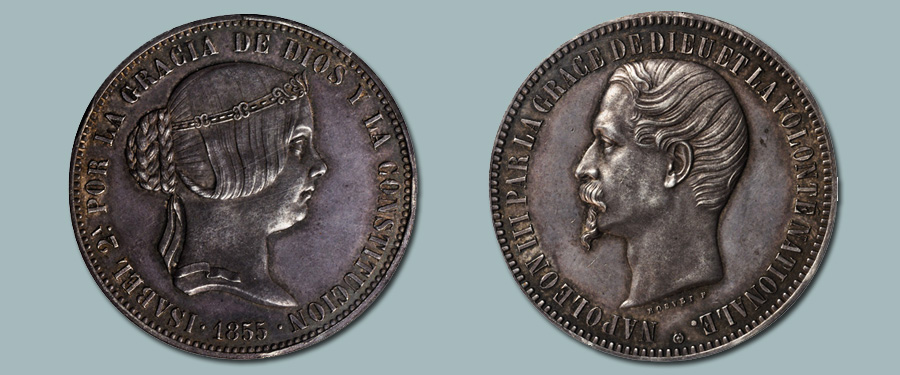
An intriguing specialty in numismatics is “pattern coinage.” While this area has long been popular in American collecting, world patterns, essais, die trials, etc. have sometimes been overlooked by collectors. In some instances, this is because some nations’ patterns have not been studied or classified in depth. The coin highlighted here has been referenced in multiple volumes and is well documented, but is actually a coin that should not even exist.
Lot 1429 in the Stack’s Bowers 2015 NYINC sale is a pattern muling, combining the unadopted obverse die for the Philippine 5 Peseta/Spanish 20 Reales and the unadopted obverse die of a French Napoleon III 5 Francs. The first obverse design was originally proposed by Louis Charles Bouvet in 1852 when he was seeking a contract to strike Spanish coins at the Paris Mint. The die, featuring the portrait of Isabella facing right, wearing her hair in a single bun and a tiara, was to have served for the Spanish 20 Reales, as well as the Philippine 5 Peseta.
In many of my blogs, I have pointed out when coins have “cross-over appeal” and can fit into more than one specialized collection. Based on the number of referenced attributions in our catalog description, this coin would fit in very well in a specialized collection of Philippine, Spanish, or French coins, world patterns, or a cabinet of rarities. Indeed, it is cataloged as: Maz-1737; V.G.-3419; cf.Cal-pg. 772 & 785; cf.Basso-70; cf.Her-138; cf.Bruce-Pn2; Forrer-Vol. I, pg. 241.
Certified as Specimen-62 by PCGS, the reflective surfaces show deep iridescent toning and a minimal number of hairlines or distracting marks. This glorious and extremely rare coin will be a centerpiece in the next collection it graces. Be sure to view this and all the other rare coins being offered in the Stack’s Bowers Galleries 2015 NYINC Showcase Auction during lot viewing or at StacksBowers.com.





